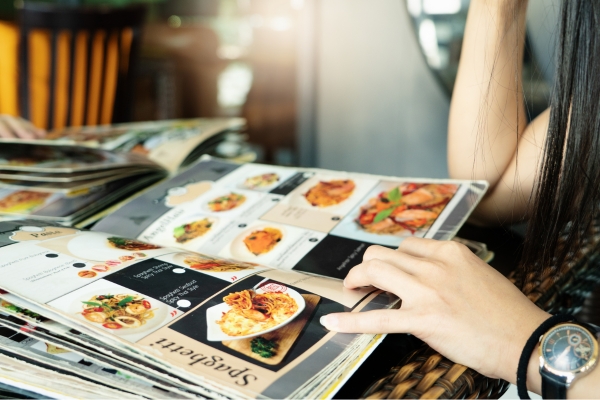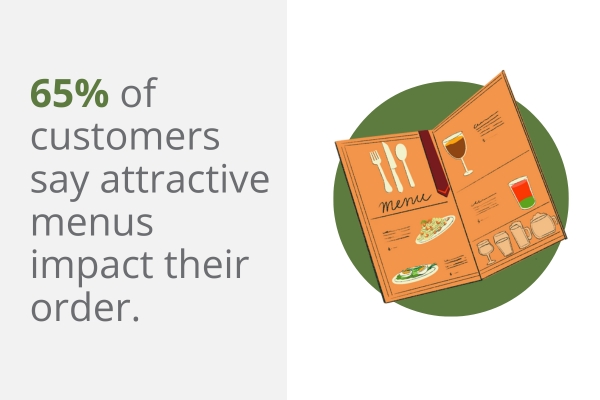September 10, 2024

Creating a menu that grabs customers' attention is vital to a successful restaurant. According to a recent study, the average customer spends nine minutes looking over a menu. A survey conducted by US Foods found that 79 percent of diners need help deciding what they want to order. Savvy menu design strategies can enhance the customer experience and direct them to high-profit dishes.
Why Restaurant Menu Design Matters
Every aspect of a restaurant makes an impression on guests, including the menu. When customers read through a menu, it’s their first introduction to your cuisine. Crafting a customer-friendly menu is crucial to grab attention.
In addition to consumer appeal, a well-designed menu can also help drive profits by influencing customers ordering behavior towards higher-ticket items. Following these four tips below can impact ordering decisions and give customers what they want.
4 Essential Elements for Effective Restaurant Menu Design
1. Layout and Organization
A well-structured menu seamlessly guides customers through your offerings. So, developing a layout and organization strategy is a critical step in menu design.
- Arrange your offerings in an instructive and intuitive way. For example, arrange dishes in order of service, starting with appetizers and ending with desserts. Consider separate menus for beverages and house specials to point guests towards high-profit items.
- Choose fonts, colors, and other design features that showcase your brand. Make sure to feature your logo prominently.
- Use white space to give your menu some breathing room. An overly crowded menu can feel overwhelming, and the goal is to allow guests to relax and enjoy their experience. Select typography that is easy to read and communicates your restaurant's ethos.
2. Visual Elements
According to the US Foods study, 65 percent of customers say attractive menus impact their order. What better way to entice customers than an array of dazzling images and colors?
Strategically placed visual elements can direct customers’ eyes toward high-ticket items, signature dishes, and specials. For example, do you want to highlight your plant-based options? Use a garden-inspired icon next to the dishes as an indicator. Also, incorporating distinct borders, elegant fonts, and photos can enhance visual appeal and catch attention.
Consider your brand colors and cuisine and incorporate them into your menu. For example, adding some cool, blue tones to the menu might be appropriate if you own a casual seafood restaurant.

3. Engaging Menu Descriptions
Menu descriptions matter and can lead to higher profits. In fact, in addition to server recommendations, menu descriptions have the most significant impact on what customers ultimately order at your restaurant.
Write compelling dish descriptions that evoke your customers’ imaginations and get them salivating. Showcase cooking techniques, highlight unique ingredients, and communicate flavor profiles. Keep the descriptions concise while still provoking a sensory experience.
4. Pricing Techniques
Restaurant owners know a properly priced menu can boost profits and customer satisfaction. However, they might need to be more familiar with how menu design can help with pricing strategies. For example, some restaurants remove the dollar sign from dish prices so customers don’t focus on costs as much.
Another way menu design influences purchasing habits is through up-selling opportunities.
- Highlighting bundle packages through visuals or a separate menu is a great way to alert customers and drive sales during slower times.
- Organize add-ons to demonstrate value and encourage customers to customize their dishes. For example, offer protein add-ons for salads, or sautéed onions/mushrooms and compound butter to steaks at an upcharge. Having a base item at a lower price point, with the option of adding delicious extras, can convince customers to spend more on their meals.
The overall goal of menu design is to balance aesthetics, information, and readability (while maximizing your profit). Keep designs clean and try to take a less-is-more approach.
US Foods CHEF’STORE Offers Next-Level Business Tools
CHEF’STORE provides essential business tools to help you bring your restaurant vision to life. Our suite of resources includes menu design, staff training, POS platforms, and more!
Contact us today and learn how to launch your restaurant into a profitable future.